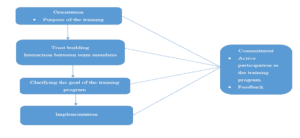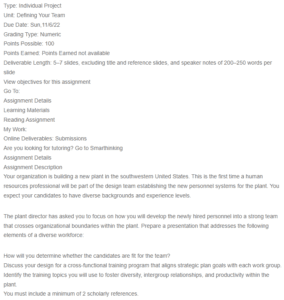Defining Your Team
How will I determine whether the candidates are fit for the team?
A team’s success is defined by the competencies and skills of team members. Therefore, it is essential to analyze the team members to determine whether they are fit. Team members should also be aware of the organization’s goals and objectives and the role of the team in achieving those objectives. One of the things I will consider in determining whether the candidates are fit for the team is reviewing the unique knowledge, skills, and competencies the candidate brings to the team. The candidate should have unique knowledge, skills, and competencies that can be leveraged to improve the team and organizational performance. I will also determine whether the candidate has previously worked in a diverse team. Diversity may include gender, cultural, and age diversity. The third thing I will consider is reviewing the candidate’s understanding of other cultures, goals, and passions and the organization’s mission, vision, and goals. I will also issue a personality assessment test to determine the candidate’s personality. I will select team members willing to ask questions and exchange ideas to improve the plant’s performance. Team members must also be good team players and embrace diversity because they will work in a diverse team.
Design for a cross-functional training program that aligns strategic plan goals with each work group
Cross-functional training includes developing employee knowledge, skills, and competencies in different organizational functions. The success of cross-functional training is determined by setting the proper support structure and focusing on specific outcomes. For example, the cross-functional training program will focus on enhancing diversity and inclusion in the organization. The cross-functional training program will begin with an orientation to inform employees about the purpose of the training. The second step will be trust building through interaction between team members. The third step will include clarifying the goal of the program. The goal will be aligned with the plant’s strategic goals and the roles and responsibilities of every employee in a workgroup. The fourth step will be the implementation of the training program. The program will also foster employee commitment through active participation and feedback on improvement areas and the program. Active participation among the team members will also include meeting the company to complete assigned roles and responsibilities. The roles and responsibilities will be delegated based on the team member’s skills and the complexity of the tasks. The impact of the training program will be measured through the performance of the team members and the application of the knowledge imparted in the training program.

Training topics that you will use to foster diversity, intergroup relationships, and productivity within the plant
One of the training topics I will use to foster diversity, intergroup relationships, and productivity within the plant is unconscious bias. The main types of unconscious bias that may affect collaboration among team members include appearance bias, affinity bias, attribution bias, confirmation bias, authority bias, and the halo effect. The halo effect may create conflict among team members by influencing team members’ lack of character. Authority bias may also limit the engagement of team members by placing more value on the team leader. According to Williamson & Foley (2018), unconscious bias training reduces stereotypes under limited conditions. Therefore, unconscious bias training should focus on defining it, how it is measured, and its impact on employees. Gino & Coffman (2021) argues that the main strategies that can be used to overcome bias are familiarizing employees with stereotyped views, reflecting on examples of countering stereotypes, gathering individualized information among employees, increasing interactions with people from different backgrounds, and adopting other people’s actives. The training will include a definition of unconscious bias, causes of unconscious bias, strategies to prevent unconscious bias, and the impact of unconscious bias on the plant. The unconscious bias training will be conducted using practical exercises and work-related assignments. The practical exercises will include group activities that require team members to avoid unconscious bias to complete a specific task.
The second topic I will use to foster diversity, intergroup relationships, and productivity within the plant is stereotypes. According to Casad & Bryant (2016), stereotypes are the main barrier to diversity and inclusion. Creating awareness of stereotypes and how to avoid them will promote diversity and intergroup relationships within the plant. Eliminating workplace stereotypes also increases employee collaboration, leading to high productivity. Stereotype training will include common stereotypes that cause discrimination and strategies to avoid stereotypes when interacting with people from different backgrounds. Stereotype training will be conducted using practical examples. The practical examples will focus on the central stereotypes that affect relations in a diverse workplace, such as religious, gender, racial, social, and cultural stereotypes. Religious beliefs and practices influence religious stereotypes. Gender stereotypes arise from generalizations about a specific gender. Racial stereotypes emerge from misconceptions about a racial and ethnic group. Social stereotypes include people’s opinions about a group of people in society. Cultural stereotypes are influenced by people’s values and beliefs and could create harmful misconceptions and beliefs among team members. The practical examples will also focus on real-life experiences with which the team members can relate. Using examples that trainees understand will increase knowledge retention.
The third topic I will use to foster diversity, intergroup relationships, and productivity within the plant is inclusion. The training will encourage employees to embrace their colleagues’ uniqueness and collaborate with them to achieve the organization’s goals. The training will consider workplace diversity issues, laws prohibiting discrimination, cultural awareness, benefits of workplace diversity, and principles of inclusion. One of the principles is access. This principle focuses on creating a welcoming environment and behaviors that encourage inclusion. The second principle is attitude. This principle focuses on people embracing diversity and inclusion and taking action to promote it. The third principle is partnerships. This principle includes looking at how employee relationships in an organization are formed and their effectiveness. The fourth principle is choice. This principle focuses on determining people and their level of involvement. The fifth principle is policy. This principle includes an organization’s commitment to diversity and inclusion. The sixth principle is communication, which considers exchanging ideas and opinions among people in the organization. The seventh principle is opportunities that encourage diversity and inclusion. Opportunities may emerge within the organization or around the organization. The inclusion training sessions will be conducted through practical examples.
References
Casad, B. J., & Bryant, W. J. (2016). Addressing stereotype threat is critical to diversity and inclusion in organizational psychology. Frontiers in Psychology, 7. https://doi.org/10.3389/fpsyg.2016.00008
Gino, F., & Coffman, K. (2021, September 1). Unconscious bias training that works. Harvard Business Review. https://hbr.org/2021/09/unconscious-bias-training-that-works
Williamson, S., & Foley, M. (2018). Unconscious bias training: The ‘Silver bullet’ for gender equity? Australian Journal of Public Administration, 77(3), 355-359. https://doi.org/10.1111/1467-8500.12313
ORDER A PLAGIARISM-FREE PAPER HERE
We’ll do everything from scratch
Question 

Defining Your Team
Type: Individual Project
Unit: Defining Your Team
Due Date: Sun,11/6/22
Grading Type: Numeric
Points Possible: 100
Points Earned: Points Earned not available
Deliverable Length: 5–7 slides, excluding title and reference slides, and speaker notes of 200–250 words per slide
View objectives for this assignment
Go To:
Assignment Details
Learning Materials
Reading Assignment
My Work:
Online Deliverables: Submissions
Are you looking for tutoring? Go to Smarthinking
Assignment Details
Assignment Description
Your organization is building a new plant in the southwestern United States. This is the first time a human resources professional will be part of the design team establishing the new personnel systems for the plant. You expect your candidates to have diverse backgrounds and experience levels.
The plant director has asked you to focus on how you will develop the newly hired personnel into a strong team that crosses organizational boundaries within the plant. Prepare a presentation that addresses the following elements of a diverse workforce:
How will you determine whether the candidates are fit for the team?
Discuss your design for a cross-functional training program that aligns strategic plan goals with each work group.
Identify the training topics you will use to foster diversity, intergroup relationships, and productivity within the plant.
You must include a minimum of 2 scholarly references.